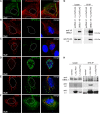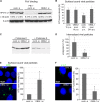The Cytoskeletal Adaptor Obscurin-Like 1 Interacts with the Human Papillomavirus 16 (HPV16) Capsid Protein L2 and Is Required for HPV16 Endocytosis
- PMID: 27654294
- PMCID: PMC5110159
- DOI: 10.1128/JVI.01222-16
The Cytoskeletal Adaptor Obscurin-Like 1 Interacts with the Human Papillomavirus 16 (HPV16) Capsid Protein L2 and Is Required for HPV16 Endocytosis
Abstract
The human papillomavirus (HPV) capsid protein L2 is essential for viral entry. To gain a deeper understanding of the role of L2, we searched for novel cellular L2-interacting proteins. A yeast two-hybrid analysis uncovered the actin-depolymerizing factor gelsolin, the membrane glycoprotein dysadherin, the centrosomal protein 68 (Cep68), and the cytoskeletal adaptor protein obscurin-like 1 protein (OBSL1) as putative L2 binding molecules. Pseudovirus (PsV) infection assays identified OBSL1 as a host factor required for gene transduction by three oncogenic human papillomavirus types, HPV16, HPV18, and HPV31. In addition, we detected OBSL1 expression in cervical tissue sections and noted the involvement of OBSL1 during gene transduction of primary keratinocytes by HPV16 PsV. Complex formation of HPV16 L2 with OBSL1 was demonstrated in coimmunofluorescence and coimmunoprecipitation studies after overexpression of L2 or after PsV exposure. We observed a strong colocalization of OBSL1 with HPV16 PsV and tetraspanin CD151 at the plasma membrane, suggesting a role for OBSL1 in viral endocytosis. Indeed, viral entry assays exhibited a reduction of viral endocytosis in OBSL1-depleted cells. Our results suggest OBSL1 as a novel L2-interacting protein and endocytosis factor in HPV infection.
Importance: Human papillomaviruses infect mucosal and cutaneous epithelia, and the high-risk HPV types account for 5% of cancer cases worldwide. As recently discovered, HPV entry occurs by a clathrin-, caveolin-, and dynamin-independent endocytosis via tetraspanin-enriched microdomains. At present, the cellular proteins involved in the underlying mechanism of this type of endocytosis are under investigation. In this study, the cytoskeletal adaptor OBSL1 was discovered as a previously unrecognized interaction partner of the minor capsid protein L2 and was identified as a proviral host factor required for HPV16 endocytosis into target cells. The findings of this study advance the understanding of a so far less well-characterized endocytic pathway that is used by oncogenic HPV subtypes.
Copyright © 2016, American Society for Microbiology. All Rights Reserved.
Figures







Similar articles
-
Cyclophilins facilitate dissociation of the human papillomavirus type 16 capsid protein L1 from the L2/DNA complex following virus entry.J Virol. 2012 Sep;86(18):9875-87. doi: 10.1128/JVI.00980-12. Epub 2012 Jul 3. J Virol. 2012. PMID: 22761365 Free PMC article.
-
The S100A10 subunit of the annexin A2 heterotetramer facilitates L2-mediated human papillomavirus infection.PLoS One. 2012;7(8):e43519. doi: 10.1371/journal.pone.0043519. Epub 2012 Aug 22. PLoS One. 2012. PMID: 22927980 Free PMC article.
-
Cleavage of the HPV16 Minor Capsid Protein L2 during Virion Morphogenesis Ablates the Requirement for Cellular Furin during De Novo Infection.Viruses. 2015 Nov 11;7(11):5813-30. doi: 10.3390/v7112910. Viruses. 2015. PMID: 26569287 Free PMC article.
-
The endocytic trafficking pathway of oncogenic papillomaviruses.Papillomavirus Res. 2019 Jun;7:135-137. doi: 10.1016/j.pvr.2019.03.004. Epub 2019 Apr 1. Papillomavirus Res. 2019. PMID: 30946955 Free PMC article. Review.
-
The evolving field of human papillomavirus receptor research: a review of binding and entry.J Virol. 2013 Jun;87(11):6062-72. doi: 10.1128/JVI.00330-13. Epub 2013 Mar 27. J Virol. 2013. PMID: 23536685 Free PMC article. Review.
Cited by
-
ADAM17-dependent signaling is required for oncogenic human papillomavirus entry platform assembly.Elife. 2019 May 20;8:e44345. doi: 10.7554/eLife.44345. Elife. 2019. PMID: 31107240 Free PMC article.
-
Retromer stabilizes transient membrane insertion of L2 capsid protein during retrograde entry of human papillomavirus.Sci Adv. 2021 Jun 30;7(27):eabh4276. doi: 10.1126/sciadv.abh4276. Print 2021 Jul. Sci Adv. 2021. PMID: 34193420 Free PMC article.
-
Whole Blood Transcriptional Fingerprints of High-Grade Glioma and Longitudinal Tumor Evolution under Carbon Ion Radiotherapy.Cancers (Basel). 2022 Jan 28;14(3):684. doi: 10.3390/cancers14030684. Cancers (Basel). 2022. PMID: 35158950 Free PMC article.
-
Heterotetrameric annexin A2/S100A10 (A2t) is essential for oncogenic human papillomavirus trafficking and capsid disassembly, and protects virions from lysosomal degradation.Sci Rep. 2018 Aug 3;8(1):11642. doi: 10.1038/s41598-018-30051-2. Sci Rep. 2018. PMID: 30076379 Free PMC article.
-
Crystal Structures of Plk1 Polo-Box Domain Bound to the Human Papillomavirus Minor Capsid Protein L2-Derived Peptide.J Microbiol. 2023 Aug;61(8):755-764. doi: 10.1007/s12275-023-00071-3. Epub 2023 Sep 8. J Microbiol. 2023. PMID: 37684534
References
MeSH terms
Substances
Grants and funding
LinkOut - more resources
Full Text Sources
Other Literature Sources
Research Materials
Miscellaneous

